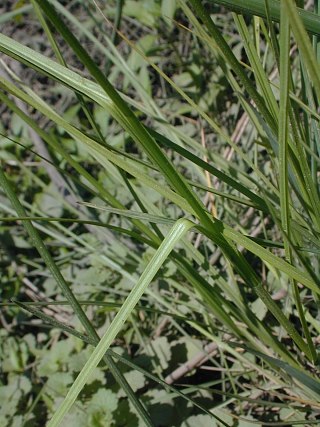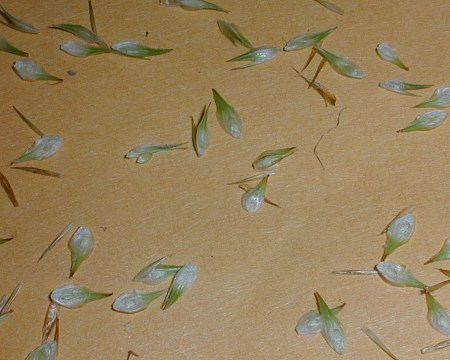Description: This perennial sedge is 1½–2½' tall, forming tight bunches of flowering culms with alternate leaves. Vegetative shoots are relatively uncommon. The culms of the fertile shoots are erect to ascending; they are light to medium green, slender, stiff, and 3-angled. Each culm is rough along its margins underneath the inflorescence. During the flowering period, 3-4 leaves occur along the lower half of each culm, while older leaves have withered away. The ascending to widely spreading leaf blades are up to 10" long and 3 mm. (1/8") across; they are light to medium green, hairless, and slender. The leaf sheaths wrap tightly around the culm; the mouth of each sheath is membranous and concave, forming a "U" shape.

Each culm terminates in an unbranched inflorescence about 1-3" long that consists of 5-10 spikelets. The spikelets can be crowded together and overlapping along the central stalk of the inflorescence, or they can be rather remote from each other and overlap very little. The spikelets are initially light green, but they become tan to brown with age. The slender bracts of the inflorescence are short, linear, and often deciduous. Each spikelet is 10-15 mm. long and 5 mm. across, consisting of a dense cluster of ascending perigynia, florets, and their bracts. The male florets are located at the bottom of each spikelet, while the female florets are located above. Each spikelet is ellipsoid in shape; it is wedge-shaped toward the bottom and rather conical and pointed at its apex. Each perigynium (a bladder-like membrane containing a female floret and its developing seed) is about 5 mm. long and 2 mm. across; it is elliptic-lanceolate in shape, becoming wedge-shaped at the bottom and tapering to a long slender beak at the apex. The margins of each perigynium are winged and membranous, even along its lower sides. Each perigynium has a pistillate scale about 4 mm. long that is narrowly lanceolate; this scale is green-veined in the center and membranous along its margins. A pair of styles protrude through the beak of each perigynium. The blooming period occurs from late spring to mid-summer. The achenes are about 1.5 mm. in length, ovoid-oblongoid in shape, and somewhat flattened. Because the perigynia of the achenes are light-weight and flat, they can be distributed to some extent by either wind or water. The root system is fibrous and short-rhizomatous.

Cultivation:
This
sedge adapts to full sun, wet to moist conditions, and various kinds of
soil, including those containing mud, sand, or gravel.
Range & Habitat:
The native Pointed Broom Sedge is occasional throughout Illinois,
although it is
slightly more common in the southern half of the state than the
northern half (see Distribution
Map). Habitats include wet prairies, marshes, fens, gravelly
seeps, margins of ponds and streams, and roadside ditches. This sedge
has been found in a wide range of wetland habitats of varying quality.
Faunal Associations:
The wind-pollinated flowers of sedges are not attractive to insect
pollinators. The foliage, juices, or seeds of sedges (Carex
spp.) are eaten by various insects, including sedge
grasshoppers (Stethophyma spp.), leafhoppers
(primarily Cosmotettix spp.), leaf beetles
(primarily Plauteumaris spp.), various aphids (Aphis
spp., Rhopalosiphum spp., Thripsaphis
spp., etc), some billbugs (Sphenophorus callosus
& Sphenophorus costicollis), and some plant
bugs (Teratocoris discolor and Mimoceps
insignis). The caterpillars of several skippers and moths
also feed on the foliage of sedges. The seeds or seedheads of wetland
sedges are sources of food to birds (ducks, rails, and some songbirds),
small rodents, and some turtles (e.g., Kinosternum subrubrum
/ Eastern Mud Turtle). Canada geese, muskrats, and other turtles (e.g.,
Chelydra serpentina / Snapping Turtle)
occasionally feed on the foliage or rhizomes of such sedges.

Photographic
Location:
Along a ditch in Urbana, Illinois.
Comments:
Pointed Broom Sedge resembles many other sedges (Carex spp.)
in Illinois, which can make it difficult to identify. It differs from
these species primarily by the conical tips and bottoms of its
spikelets. This sedge also has narrow leaf blades (typically 3 mm.
across or less) that are shorter than its culms. The perigynia of
Pointed Broom Sedge are more slender and longer than those of many
other sedges, and they usually have wedge-shaped bottoms with
membranous winged margins. Many other sedges have perigynia with
well-rounded bottoms that lack such margins. Another species, Carex
tribuloides (Blunt Broom Sedge), is fairly similar in
appearance, but its culms are more leafy with wider blades, and the
tops of its spikelets are more blunt. This latter sedge prefers
wetlands that are more shady.